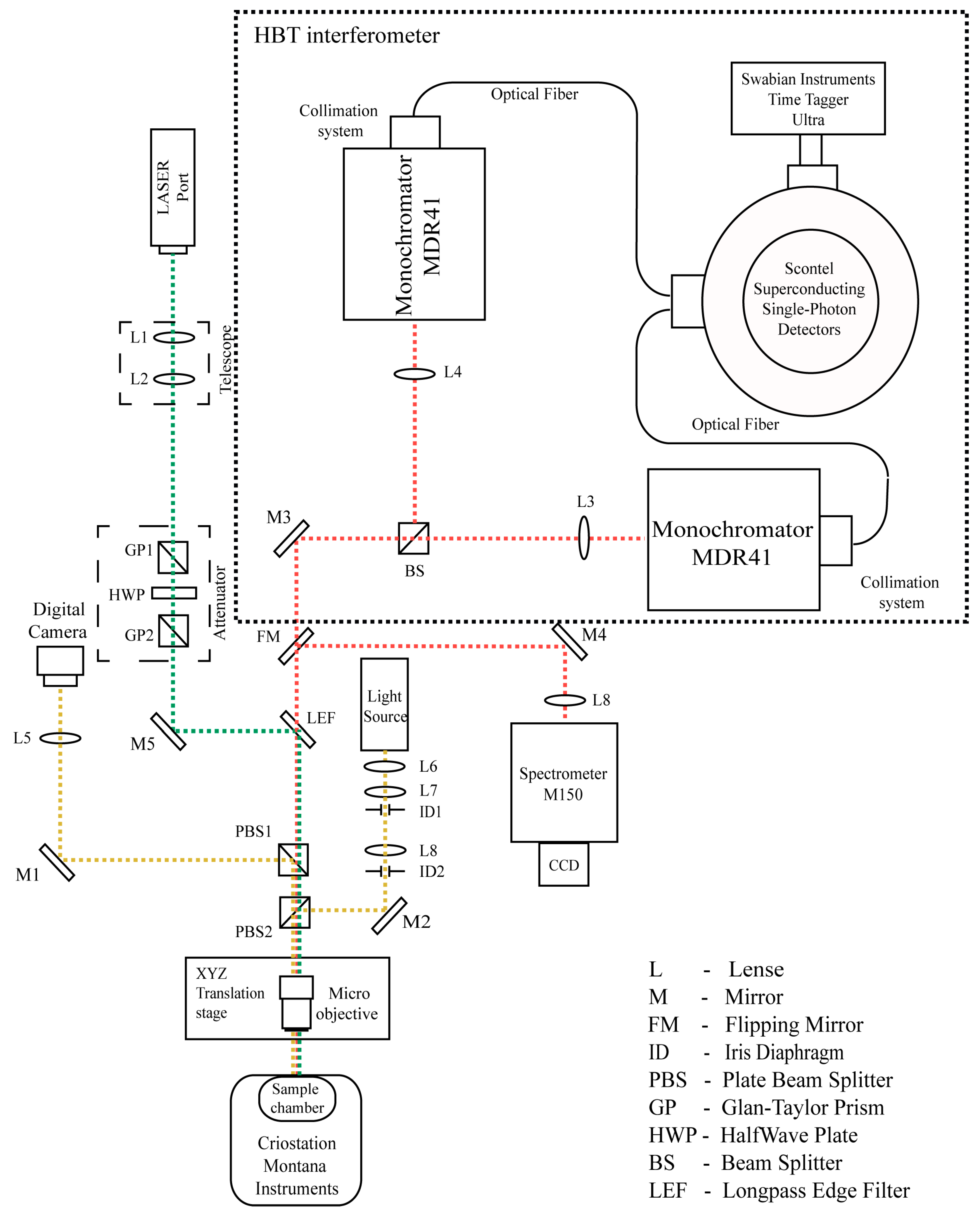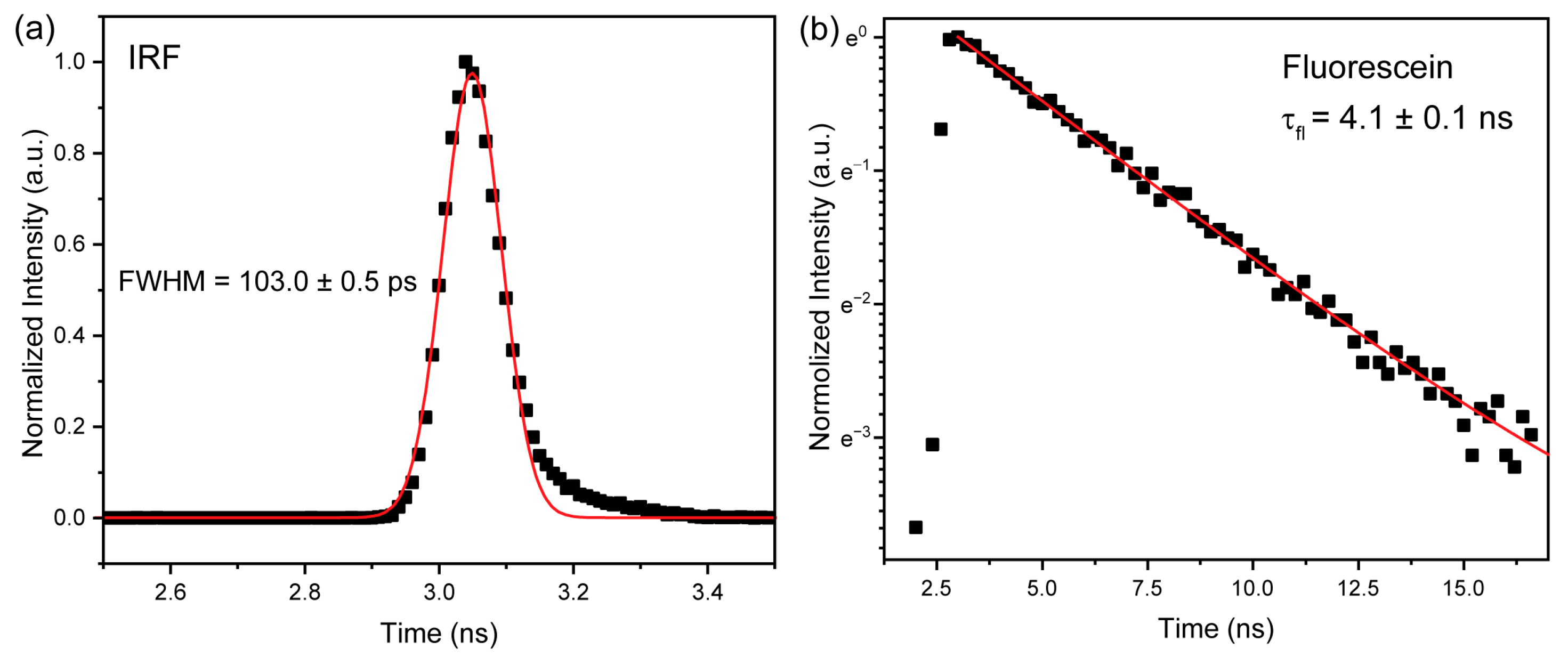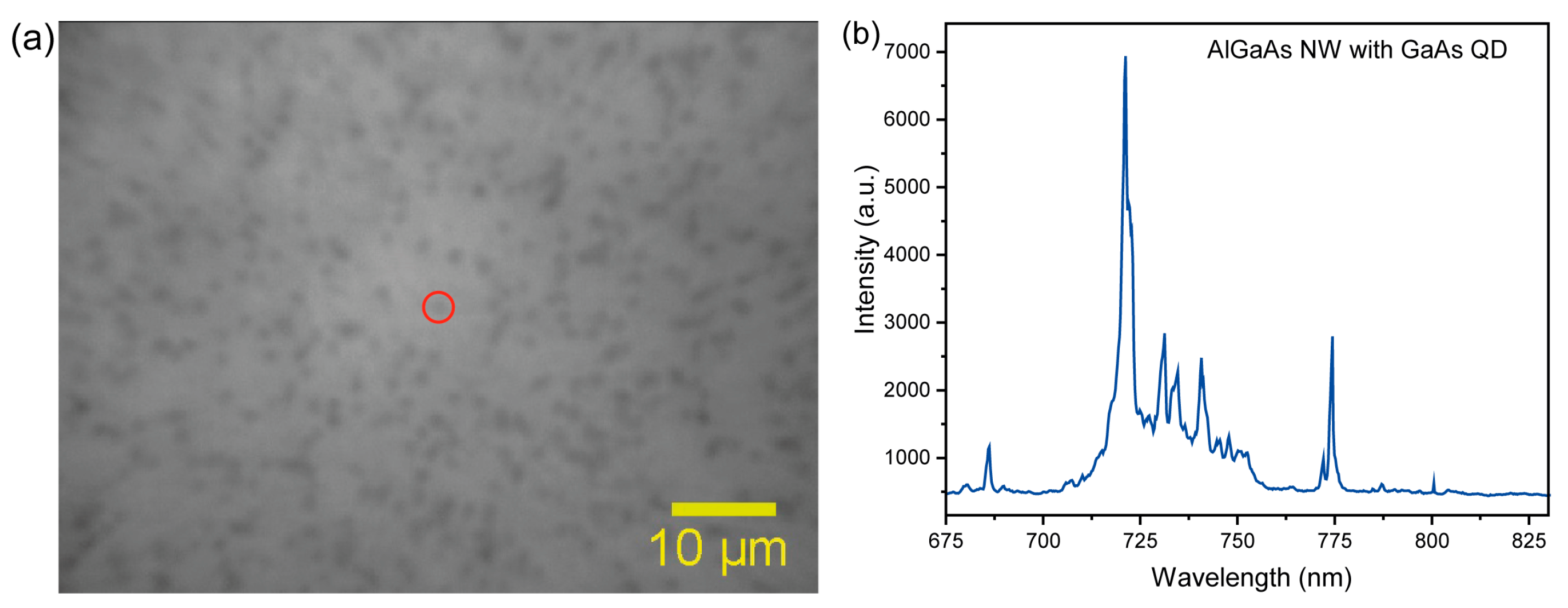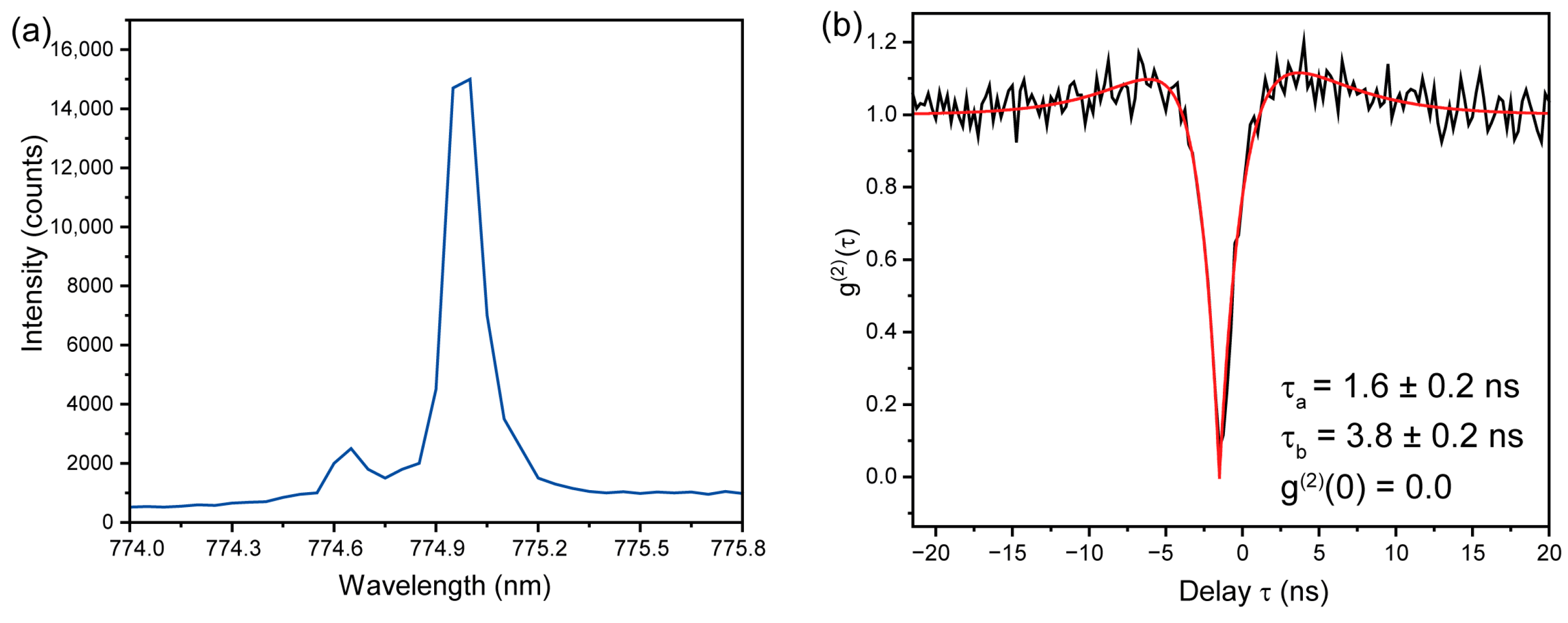Methodological Approach to the Characterization of Single-Photon Sources Using a Hanbury Brown–Twiss Interferometer in a Laser-Excited Fluorescence Microscope
Abstract
1. Introduction
2. Materials and Methods
2.1. General Description
2.2. Microscope
2.2.1. Microscope Illumination
2.2.2. Microscope Objective
2.2.3. Microscope Camera
2.2.4. Microscope Translator
2.3. Excitation
2.3.1. Light Source
2.3.2. Beam Input
2.4. Registration System
2.4.1. Detectors
2.4.2. Monochromators
2.4.3. Time-to-Digital Converter
3. Results
3.1. Instrument Response Function
3.2. Autocorrelation Measurements
4. Conclusions
Author Contributions
Funding
Data Availability Statement
Acknowledgments
Conflicts of Interest
References
- Bassett, L.C.; Alkauskas, A.; Exarhos, A.L.; Fu, K.-M.C. Quantum Defects by Design. Nanophotonics 2019, 8, 1867–1888. [Google Scholar] [CrossRef]
- Pelant, I.; Valenta, J. Luminescence Spectroscopy of Semiconductors; Oxford University Press: Oxford, UK, 2012; ISBN 0199588333. [Google Scholar]
- Peter, Y.U.; Cardona, M. Fundamentals of Semiconductors: Physics and Materials Properties; Springer Science & Business Media: Berlin/Heidelberg, Germany, 2010; ISBN 3642007104. [Google Scholar]
- Koch, S.W.; Kira, M.; Khitrova, G.; Gibbs, H.M. Semiconductor Excitons in New Light. Nat. Mater. 2006, 5, 523–531. [Google Scholar] [CrossRef] [PubMed]
- Scholes, G.D.; Rumbles, G. Excitons in Nanoscale Systems. Nat. Mater. 2006, 5, 683–696. [Google Scholar] [CrossRef]
- Yam, F.K.; Hassan, Z. Innovative Advances in LED Technology. Microelectron. J. 2005, 36, 129–137. [Google Scholar] [CrossRef]
- Avrutin, V.; Izyumskaya, N.; Morkoç, H. Semiconductor Solar Cells: Recent Progress in Terrestrial Applications. Superlattices Microstruct. 2011, 49, 337–364. [Google Scholar] [CrossRef]
- Baranov, A.; Tournié, E. Semiconductor Lasers: Fundamentals and Applications; Woodhead Publishing: Cambridge, UK, 2013. [Google Scholar]
- Wheeler, D.A.; Zhang, J.Z. Exciton Dynamics in Semiconductor Nanocrystals. Adv. Mater. 2013, 25, 2878–2896. [Google Scholar] [CrossRef]
- Kambhampati, P. Unraveling the Structure and Dynamics of Excitons in Semiconductor Quantum Dots. Acc. Chem. Res. 2011, 44, 1–13. [Google Scholar] [CrossRef]
- Sze, S.M. Semiconductor Devices: Physics and Technology; John Wiley & Sons: Hoboken, NJ, USA, 2008; ISBN 812651681X. [Google Scholar]
- Nozik, A.J. Spectroscopy and Hot Electron Relaxation Dynamics in Semiconductor Quantum Wells and Quantum Dots. Annu. Rev. Phys. Chem. 2001, 52, 193–231. [Google Scholar] [CrossRef]
- Bimberg, D.; Pohl, U.W. Quantum Dots: Promises and Accomplishments. Mater. Today 2011, 14, 388–397. [Google Scholar] [CrossRef]
- Quan, L.N.; Kang, J.; Ning, C.-Z.; Yang, P. Nanowires for Photonics. Chem. Rev. 2019, 119, 9153–9169. [Google Scholar] [CrossRef]
- Radtke, M.; Bernardi, E.; Slablab, A.; Nelz, R.; Neu, E. Nanoscale Sensing Based on Nitrogen Vacancy Centers in Single Crystal Diamond and Nanodiamonds: Achievements and Challenges. Nano Futur. 2019, 3, 042004. [Google Scholar] [CrossRef]
- Shields, A.J. Semiconductor Quantum Light Sources. Nat. Photonics 2007, 1, 215–223. [Google Scholar] [CrossRef]
- Senellart, P.; Solomon, G.; White, A. High-Performance Semiconductor Quantum-Dot Single-Photon Sources. Nat. Nanotechnol. 2017, 12, 1026–1039. [Google Scholar] [CrossRef] [PubMed]
- Heindel, T.; Kim, J.-H.; Gregersen, N.; Rastelli, A.; Reitzenstein, S. Quantum Dots for Photonic Quantum Information Technology. Adv. Opt. Photonics 2023, 15, 613–738. [Google Scholar] [CrossRef]
- Arakawa, Y.; Holmes, M.J. Progress in Quantum-Dot Single Photon Sources for Quantum Information Technologies: A Broad Spectrum Overview. Appl. Phys. Rev. 2020, 7, 021309. [Google Scholar] [CrossRef]
- Elshaari, A.W.; Pernice, W.; Srinivasan, K.; Benson, O.; Zwiller, V. Hybrid Integrated Quantum Photonic Circuits. Nat. Photonics 2020, 14, 285–298. [Google Scholar] [CrossRef]
- Subramani, S.; Svn, S.K. Review of Security Methods Based on Classical Cryptography and Quantum Cryptography. Cybern. Syst. 2025, 56, 302–320. [Google Scholar] [CrossRef]
- Vamivakas, A.N.; Atatüre, M. Photons and (Artificial) Atoms: An Overview of Optical Spectroscopy Techniques on Quantum Dots. Contemp. Phys. 2010, 51, 17–36. [Google Scholar] [CrossRef]
- Efros, A.L.; Nesbitt, D.J. Origin and Control of Blinking in Quantum Dots. Nat. Nanotechnol. 2016, 11, 661–671. [Google Scholar] [CrossRef]
- Sallen, G.; Tribu, A.; Aichele, T.; André, R.; Besombes, L.; Bougerol, C.; Richard, M.; Tatarenko, S.; Kheng, K.; Poizat, J.-P. Subnanosecond Spectral Diffusion Measurement Using Photon Correlation. Nat. Photonics 2010, 4, 696–699. [Google Scholar] [CrossRef]
- Messin, G.; Hermier, J.-P.; Giacobino, E.; Desbiolles, P.; Dahan, M. Bunching and Antibunching in the Fluorescence of Semiconductor Nanocrystals. Opt. Lett. 2001, 26, 1891–1893. [Google Scholar] [CrossRef] [PubMed]
- Eremchev, I.Y.; Tarasevich, A.O.; Kniazeva, M.A.; Li, J.; Naumov, A.V.; Scheblykin, I.G. Detection of Single Charge Trapping Defects in Semiconductor Particles by Evaluating Photon Antibunching in Delayed Photoluminescence. Nano Lett. 2023, 23, 2087–2093. [Google Scholar] [CrossRef] [PubMed]
- Zwiller, V.; Aichele, T.; Benson, O. Single-Photon Fourier Spectroscopy of Excitons and Biexcitons in Single Quantum Dots. Phys. Rev. B 2004, 69, 165307. [Google Scholar] [CrossRef]
- Brown, R.H.; Twiss, R.Q. Correlation between Photons in Two Coherent Beams of Light. Nature 1956, 177, 27–29. [Google Scholar] [CrossRef]
- Loudon, R. The Quantum Theory of Light; OUP Oxford: Oxford, UK, 2000; ISBN 0191589780. [Google Scholar]
- Bhattacharya, P.; Ghosh, S.; Stiff-Roberts, A.D. Quantum Dot Opto-Electronic Devices. Annu. Rev. Mater. Res. 2004, 34, 1–40. [Google Scholar] [CrossRef]
- García de Arquer, F.P.; Talapin, D.V.; Klimov, V.I.; Arakawa, Y.; Bayer, M.; Sargent, E.H. Semiconductor Quantum Dots: Technological Progress and Future Challenges. Science 2021, 373, eaaz8541. [Google Scholar] [CrossRef]
- Yu, Y.; Liu, S.; Lee, C.-M.; Michler, P.; Reitzenstein, S.; Srinivasan, K.; Waks, E.; Liu, J. Telecom-Band Quantum Dot Technologies for Long-Distance Quantum Networks. Nat. Nanotechnol. 2023, 18, 1389–1400. [Google Scholar]
- Kiraz, A.; Fälth, S.; Becher, C.; Gayral, B.; Schoenfeld, W.V.; Petroff, P.M.; Zhang, L.; Hu, E.; Imamoğlu, A. Photon Correlation Spectroscopy of a Single Quantum Dot. Phys. Rev. B 2002, 65, 161303. [Google Scholar] [CrossRef]
- Becker, W. The Bh TCSPC Handbook; Becker & Hickl: Berlin, Germany, 2019; Available online: http://www.becker-hickl.de (accessed on 20 August 2019).
- Amelinckx, S.; Van Dyck, D.; van Landuyt, J.; Van Tendeloo, G. Handbook of Microscopy: Applications in Materials Science, Solid-State Physics and Chemistry. Prakt. Met. 1997, 34, 11. [Google Scholar]
- Bass, M.; Van Stryland, E.W.; Williams, D.R.; Wolfe, W.L. Handbook of Optics; McGraw-Hill: New York, NY, USA, 1995; Volume 2. [Google Scholar]
- Seybold, P.G.; Gouterman, M.; Callis, J. Calorimetric, Photometric and Lifetime Determinations of Fluorescence Yields of Fluorescein Dyes. Photochem. Photobiol. 1969, 9, 229–242. [Google Scholar] [CrossRef]
- Zhang, X.-F.; Zhang, J.; Liu, L. Fluorescence Properties of Twenty Fluorescein Derivatives: Lifetime, Quantum Yield, Absorption and Emission Spectra. J. Fluoresc. 2014, 24, 819–826. [Google Scholar] [CrossRef] [PubMed]
- Minami, T.; Kawahigashi, M.; Sakai, Y.; Shimamoto, K.; Hirayama, S. Fluorescence Lifetime Measurements under a Microscope by the Time-Correlated Single-Photon Counting Technique. J. Lumin. 1986, 35, 247–253. [Google Scholar] [CrossRef]
- Martin, M.M.; Lindqvist, L. The PH Dependence of Fluorescein Fluorescence. J. Lumin. 1975, 10, 381–390. [Google Scholar]
- Klonis, N.; Sawyer, W.H. Spectral Properties of the Prototropic Forms of Fluorescein in Aqueous Solution. J. Fluoresc. 1996, 6, 147–157. [Google Scholar] [CrossRef] [PubMed]
- Leandro, L.; Gunnarsson, C.P.; Reznik, R.; Jöns, K.D.; Shtrom, I.; Khrebtov, A.; Kasama, T.; Zwiller, V.; Cirlin, G.; Akopian, N. Nanowire Quantum Dots Tuned to Atomic Resonances. Nano Lett. 2018, 18, 7217–7221. [Google Scholar] [CrossRef]
- Brouri, R.; Beveratos, A.; Poizat, J.-P.; Grangier, P. Photon Antibunching in the Fluorescence of Individual Color Centers in Diamond. Opt. Lett. 2000, 25, 1294–1296. [Google Scholar] [CrossRef]
- Perera, S.; Fickenscher, M.A.; Jackson, H.E.; Smith, L.M.; Yarrison-Rice, J.M.; Joyce, H.J.; Gao, Q.; Tan, H.H.; Jagadish, C.; Zhang, X. Nearly Intrinsic Exciton Lifetimes in Single Twin-Free GaAs∕AlGaAs Core-Shell Nanowire Heterostructures. Appl. Phys. Lett. 2008, 93, 053110. [Google Scholar]
- Wolford, D.J.; Gilliland, G.D.; Kuech, T.F.; Smith, L.M.; Martinsen, J.; Bradley, J.A.; Tsang, C.F.; Venkatasubramanian, R.; Ghandi, S.K.; Hjalmarson, H.P. Intrinsic Recombination and Interface Characterization in “Surface-free” GaAs Structures. J. Vac. Sci. Technol. B Microelectron. Nanom. Struct. Process. Meas. Phenom. 1991, 9, 2369–2376. [Google Scholar] [CrossRef]





Disclaimer/Publisher’s Note: The statements, opinions and data contained in all publications are solely those of the individual author(s) and contributor(s) and not of MDPI and/or the editor(s). MDPI and/or the editor(s) disclaim responsibility for any injury to people or property resulting from any ideas, methods, instructions or products referred to in the content. |
© 2025 by the authors. Licensee MDPI, Basel, Switzerland. This article is an open access article distributed under the terms and conditions of the Creative Commons Attribution (CC BY) license (https://creativecommons.org/licenses/by/4.0/).
Share and Cite
Mikushev, S.; Kalinichev, A. Methodological Approach to the Characterization of Single-Photon Sources Using a Hanbury Brown–Twiss Interferometer in a Laser-Excited Fluorescence Microscope. Quantum Beam Sci. 2025, 9, 30. https://doi.org/10.3390/qubs9040030
Mikushev S, Kalinichev A. Methodological Approach to the Characterization of Single-Photon Sources Using a Hanbury Brown–Twiss Interferometer in a Laser-Excited Fluorescence Microscope. Quantum Beam Science. 2025; 9(4):30. https://doi.org/10.3390/qubs9040030
Chicago/Turabian StyleMikushev, Sergey, and Aleksei Kalinichev. 2025. "Methodological Approach to the Characterization of Single-Photon Sources Using a Hanbury Brown–Twiss Interferometer in a Laser-Excited Fluorescence Microscope" Quantum Beam Science 9, no. 4: 30. https://doi.org/10.3390/qubs9040030
APA StyleMikushev, S., & Kalinichev, A. (2025). Methodological Approach to the Characterization of Single-Photon Sources Using a Hanbury Brown–Twiss Interferometer in a Laser-Excited Fluorescence Microscope. Quantum Beam Science, 9(4), 30. https://doi.org/10.3390/qubs9040030





